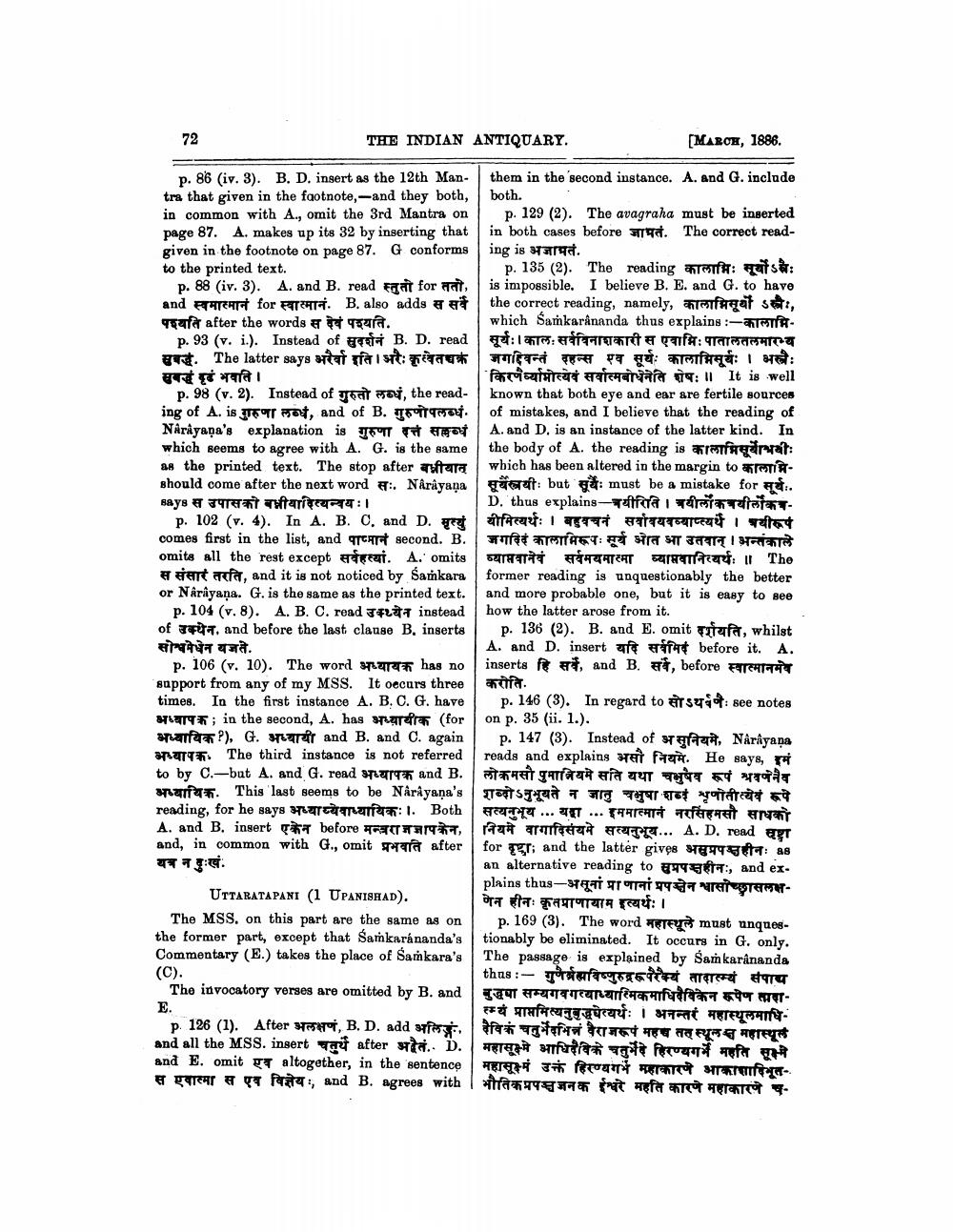________________
72
THE INDIAN ANTIQUARY.
MAROH, 1886.
p.86 (iv. 3). B. D. insert as the 12th Man- | them in the second instance. A.and G. include tra that given in the faotnote, and they both, both. in common with A., omit the 3rd Mantra on p. 129 (2). The avagraha must be inserted page 87. A. makes up its 32 by inserting that | in both cases before जापतं. The correct readgiven in the footnote on page 87. G conforms ing is अजाप्रतं. to the printed text.
____p. 135 (2). The reading कालामिः सूर्योः p. 88 (iv. 3). A. and B. read raait for it, is impossible. I believe B. E. and G. to have and स्वमात्मानं for स्वास्मानं. B.also adds स सर्वे the correct reading, namely, a faqat si, पश्यति after the words स देवं पश्यति.
which Samkarinanda thus explains:-कालामिp.93 (v. i). Instead of सुदर्शनं B. D. read | सूर्यः। काल: सर्वविनाशकारी स एवाग्निः पातालतलमारभ्य सबद्ध. The latter says अरैर्वा इति । अरैः कृपेतचक्र | जगदिवन्तं दहन्स एव सूर्यः कालानिसूर्यः । अस्पैः सब दृढं भवति।
| किरणामोत्येवं सर्वात्मबोधेनेति शेषः॥ It is well ___p.98 (v. 2). Instead of गुरुतो लब्धं, the read- known that both eye and ear are fertile sources ing of A. is गुरुणा लब्ध, and of B. गुरुणोपलब्ध. of mistakes, and I believe that the reading of Narayapa's explanation is गुरुणा र सलब्ध A.and D. is an instance of the latter kind. In which seems to agree with A. G. is the same | the body of A. the reading is कालानिसूर्याभवीः as the printed text. The stop after aftara which has been altered in the margin to कालाग्निshould come after the next word सः. Nariyana सूर्येस्त्रयीः but सूर्यैः must be a mistake for सूर्यः. Bays स उपासको बानीयादित्यन्वयः।
D. thus explains-त्रयीरिति । त्रयीलोकत्रयीलाका___. 102 (v. 4). In A. B. C. and D. मृत्यु यीमित्यर्थः । बहुवचनं सर्वावयवव्याप्त्यर्थ । यीरूप comes first in the list, and car second. B. जगदिदं कालामिरूपः सूर्य ओत आ उतवान् । अन्तंकाले omits all the rest except सर्वहत्यां . A. omits व्याप्तवानेवं सर्वमयमात्मा व्याप्तवानित्यर्थः ॥ The स संसार तरति, and it is not noticed by Samkara | former reading is unquestionably the better or Narayana. G. is the same as the printed text. and more probable one, but it is easy to see
p. 104 (v.8). A. B.C. read उक्थ्ये न instead | of उक्थे न. and before the last clanse B. inserts ____p. 136 (2). B. and E. omit दर्शयति, whilst सोधमेधेन बजते.
A. and D. insert यदि सर्वमिदं before it. A. p. 106 (v. 10). The word अध्यायक has no | inserts हि सर्वे, and B. सर्वे, before स्वास्मानमेव support from any of my MSS. It occurs three करोति. times. In the first instance A. B.C.G. have p. 146 (3). In regard to सोऽयः see notes अध्यापक; in the second, A. has अभ्यायीक (for | on p. 35 (ii. 1.). अध्याबिक), G. अध्यायी and B. and C. again | p. 147 (3). Instead of असुनियमे, Nariyana TUTTh The third instance is not referred rends and explains असौ नियम. He says, मं to by C.-but A. and G. read अध्यापक and B. लोकमसी पुमानियमे सति यथा चभुषेव रूपं श्रवणेनैव अभ्याथिक. This last seems to be Nariyana's शब्दोऽनुभूयते न जानु चक्षुषा शब्द शृणोतीत्येवं रूपे reading, for he says अध्याय्येवाध्यायिकः1. Both सत्यनुभूय ... यहा ... इममात्मानं नरसिंहमसौ साधको A. and B. insert एकेन before मन्त्रराजजापकेन, नियमे वागादिसंयमे सत्यनुभूय... A. D. read Rष्टा and, in common with G., omit प्रभवति after | for दृष्टा; and the latter gives असुप्रपमहीनः as यत्र न दुःखं.
an alternative reading to सुप्रपमहीनः, and ex.
plains thug-असूनां प्राणानां प्रपन श्वासोच्छासलक्षUTTARATAPANI (1 UPANISHAD).
णेन हीनः कृतप्राणायाम इत्यर्थः । The MSS. on this part are the same as on ___p. 169 (3). The word महास्थूले must unquesthe former part, except that Samkaránanda's tionably be eliminated. It occurs in G. only. Commentary (E.) takes the place of Samkara's The passage is explained by Sam karAnanda (C).
thus:- गुणैर्ब्रह्मविष्णुरुद्ररूपरक्यं तादात्म्यं संपाय The invocatory verses are omitted by B. and बुद्धपा सम्यगवगत्याध्यात्मिकमाधिदैविकेन रूपेण तादा
रम्य प्राप्तमित्यनुबद्धघेत्यर्थः । अनन्तरं महास्थूलमाधिp. 126 (1). After अलक्षणं, B. D. add अलिङ्गं, देविकं चतुर्भवभिनं वैराजरूपं महच तत् स्थूलश महास्थूल and all the MSS. insert चतुर्थे after भौतं.. D. महासूझमे आधिदैविके चतुर्भेदे हिरण्यगर्ने महति सूक्ष्म and E. omit te altogether, in the sentence महासूक्ष्म उक्त हिरण्यगर्भ महाकारणे आकाशाविभूतस एवास्मा स एव विज्ञेयः, and B. agrees with | भौतिकप्रपञ्चजनक ईश्वरे महति कारणे महाकारणे च.
E.




